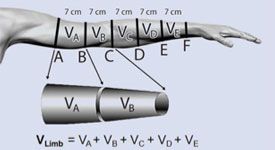Article
New Nomogram Tools Predict Risk of Lymphedema
Author(s):
A new set of statistical models will soon be available to help predict the risk of lymphedema for patients with breast cancer who have undergone ALND.

Online arm volume calculator
A new set of statistical models will soon be available to help predict the risk of lymphedema for patients with breast cancer who have undergone axillary lymph node dissection (ALND).
Jose Bevilacqua, MD, PhD, a surgical oncologist at Hospital Sirio Libanes in Sao Paulo, Brazil, announced the 3 nomograms for different treatment stages Tuesday during an American Association of Clinical Oncology (ASCO) presscast. His research will be presented this week during ASCO’s 2011 Breast Cancer Symposium in San Francisco, California.
The nomograms calculate the risk preoperatively, within the first 6 months after surgery, and ≥6 months after surgery, and demonstrate an accuracy rate of more than 70%, similar to the performance of mammography, Bevilacqua said.
The study is the largest-ever prospective examination of lymphedema occurrence and is the first to show an association between arm lymphedema and ipsilateral neoadjuvant chemotherapy infusion, Bevilacqua said in a slide presentation.
He said the models will serve as good statistical tools for predicting lymphedema, helping clinicians detect the potentially disabling swelling at an earlier stage and consider referring the patient for physical therapy.
Andrew D. Seidman, MD, a medical oncologist at Memorial Sloan-Kettering Cancer Center in New York City who moderated the presscast, said the effectiveness of lymphedema therapies remains a source of debate.
He said the nomograms can help identify patients who would benefit from symptom management techniques such as the use of compression garments, moderate exercise, and avoiding lifting heavy backpacks or pocketbooks.
To develop the nomograms, Bevilacqua and colleagues analyzed the experiences of 1054 patients with unilateral breast cancer who underwent ALND (levels I through III) and either breast conservation therapy or mastectomy in Brazil from August 2001 to November 2002.
Investigators considered such factors as age, body mass index, cycles of neoadjuvant chemotherapy, location of radiotherapy, and development of seroma and early edema.
Bevilacqua said lymphedema occurs in approximately 30% of patients who have had ALND. Approximately 25% of patients with breast cancer undergo ALND, and approximately 150,000 women worldwide develop lymphedema annually.
A free online arm volume calculator is available at www.armvolume.com . The nomogram models will be available free of charge at www.lymphedemarisk.com after the research is published, although it can be accessed during the symposium.
All symposium abstracts are posted at breastcasymposium.org .
Bevilacqua JL, Kattan MW, Yu C, et al. Nomograms for predicting the risk of arm lymphedema after axillary dissection in breast cancer. In: Proceedings from the 2011 Breast Cancer Symposium of the American Society of Clinical Oncology; September 8-10, 2011; San Francisco, CA. Abstract 8.









